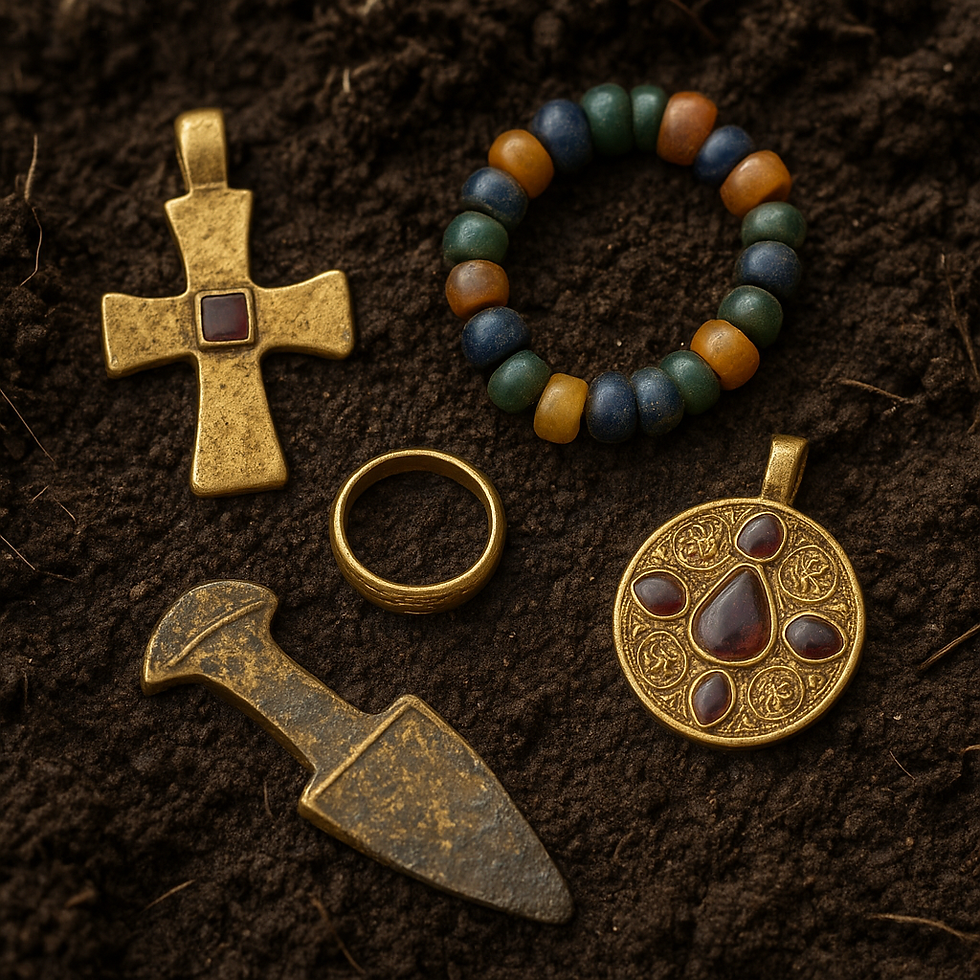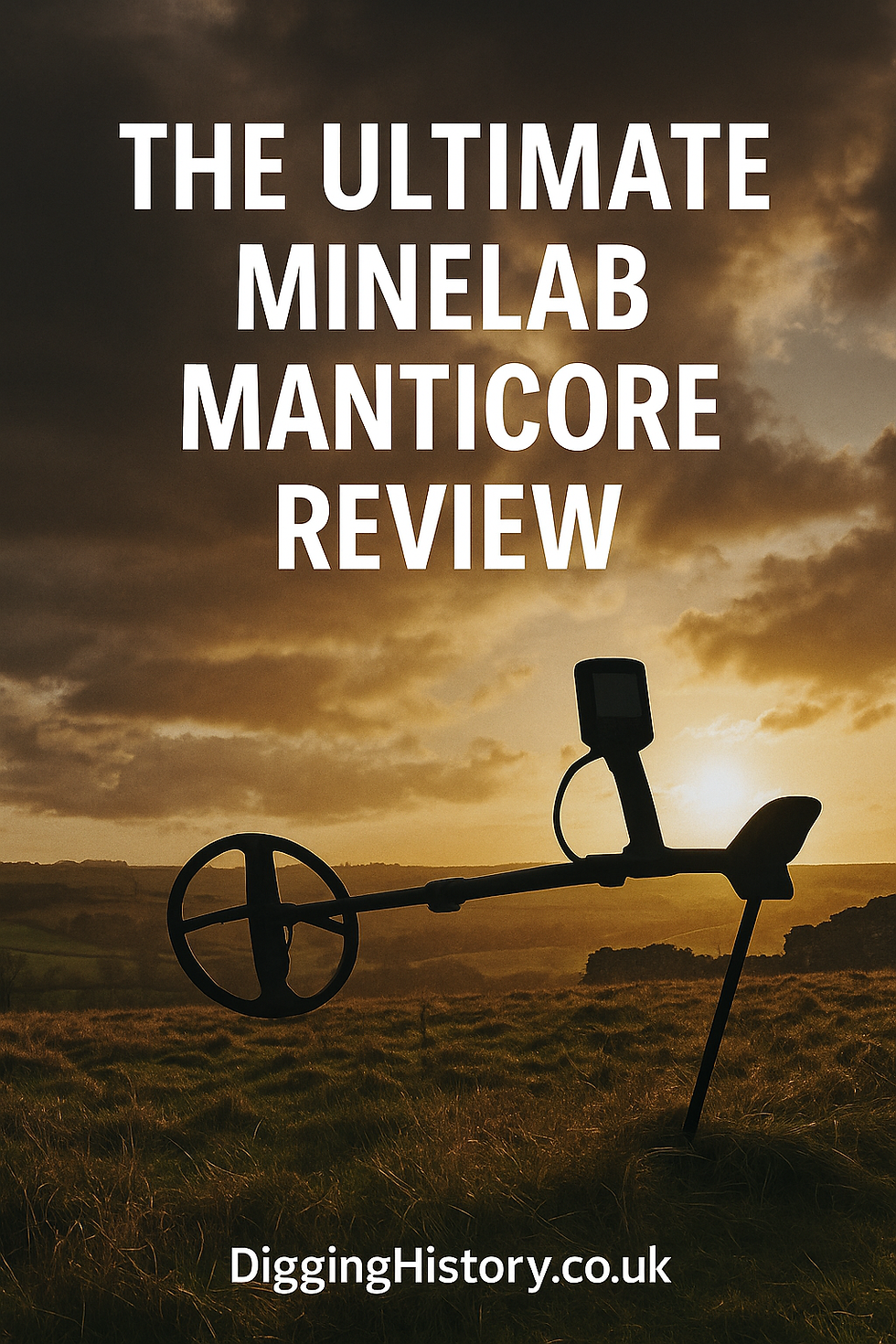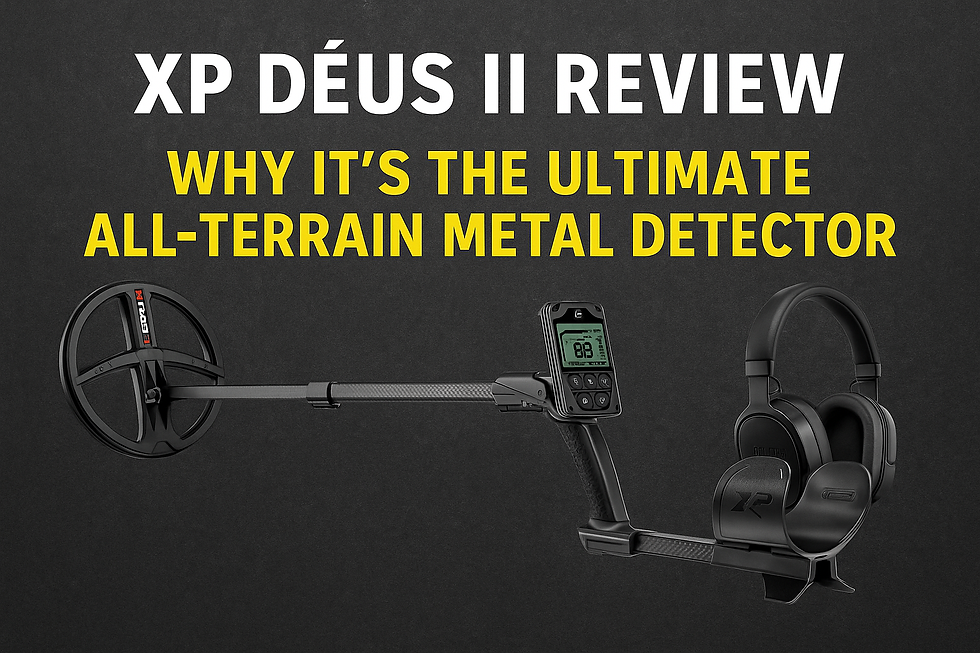Anglo-Saxon Britain & Metal Detecting: The Ultimate Guide to Unearthing Treasure from AD 410–1066
- DiggingHistory.co.uk
- Sep 21
- 5 min read
When Rome withdrew from Britain around AD 410, new peoples, Angles, Saxons, and Jutes, crossed the North Sea and reshaped the island’s culture. For six centuries, Britain was a patchwork of kingdoms, churches, and battlefields until the Norman Conquest in 1066.
This era left behind brooches, coins, weapons, jewellery, tools, and burials, all of which turn up today under detectorists’ coils. The Anglo-Saxon period is not just famous for treasures like Sutton Hoo and the Staffordshire Hoard; it’s also rich in lesser-known but no less fascinating finds that detectorists continue to report.
This guide explores Anglo-Saxon Britain from a detectorist’s perspective: what they left, why objects ended up in the soil, where you might encounter them, and how to record them responsibly under UK law.

Anglo-Saxon Britain at a Glance (AD 410–1066)
AD 410 – Roman administration withdraws. Britain left vulnerable.
5th–6th centuries – Early Anglo-Saxon migration and settlement. Pagan religion dominates.
7th century – Christianisation spreads; ornate jewellery, burial goods, and church treasures appear.
8th–9th centuries – Kingdoms consolidate (Mercia, Wessex, Northumbria). Trade expands; silver coinage stabilises.
9th–10th centuries – Viking raids, settlements, and hoards overlap with Saxon material.
11th century – Edward the Confessor’s coinage; Harold II; ends with the Norman Conquest (1066).
Each phase left its own detectable footprint: early pagan brooches, mid-Saxon coinage, Viking-Anglo-Saxon hoards, and late Saxon pennies.
Material Culture: Brooches & Dress Fittings Left Behind
Brooches & Dress Fittings

Brooches are among the most distinctive Saxon finds. Types include:
Cruciform brooches – tall, cross-shaped, popular in the 5th–6th centuries.
Saucer brooches – circular, often gilded, with geometric designs.
Square-headed brooches – large, decorated, high-status.
Disc brooches – flat, with intricate motifs.
Later styles include penannular brooches and continental imports.
Dress fittings like buckles, strap-ends, and pins also surface regularly.
Jewellery

Gold and garnet jewellery defines high-status Anglo-Saxon culture. Detectorists occasionally find:
Pendant crosses (Christian era).
Beads of glass or amber.
Finger rings (gold or silver).
Necklace pendants, such as the famous Winfarthing pendant (Norfolk, 2014), a stunning garnet and gold piece found by a detectorist.
Weapons & Tools

Though iron corrodes, detectorists sometimes uncover:
Sword fittings, pommels, and scabbard mounts.
Spearheads and shield bosses.
Knives and seaxes.
Tools like awls, keys, and agricultural implements.
Coins
Saxon coinage evolved from early sceattas (small silver coins, 7th–8th century) to stycas (copper-alloy coins of Northumbria), then later pennies in silver from the 9th century onwards. These coins are vital for dating.
Famous coin hoards:
Lenborough Hoard (Buckinghamshire, 2014) – over 5,200 coins of Æthelred II and Cnut.
Chew Valley Hoard (Somerset, 2019) – rare pennies of Harold II and William the Conqueror, showing the Norman transition.
Burial Practices & Detecting
Early Anglo-Saxons often practised inhumation with grave goods: brooches, weapons, jewellery. Famous sites like Sutton Hoo (Suffolk) revealed ship burials with treasures, though Sutton Hoo itself was archaeologically excavated, not detected, it set the tone for what might lie beneath ordinary fields.
Detectorists have helped identify smaller cemeteries:
Cumwhitton (Cumbria, 2004) – detectorists discovered a 10th-century Viking-Anglo-Saxon warrior cemetery with weapons, beads, and fittings.
By the Christian era, grave goods decline, but cross pendants, rings, and reliquaries still appear.
Warfare, Raids & Lost Wealth
The Saxon period was marked by constant conflict:
Inter-kingdom wars (e.g., Northumbria vs Mercia).
Viking raids and invasions from the late 8th century.
Danelaw period, with Scandinavian and Anglo-Saxon culture overlapping.
Conflict produced hoards buried for safekeeping, sometimes never retrieved. Detectorists continue to find these caches:
Staffordshire Hoard (2009) – over 3,500 items of gold, silver, and garnet fittings, likely war booty from the 7th century. Found by detectorist Terry Herbert in Staffordshire.
Bedale Hoard (Yorkshire, 2012) – Viking-age but includes Anglo-Saxon sword fittings, showing cultural blend.
Religion & Ritual
Pagan Beliefs
Artefacts like idols, amulets, and animal motifs reflect pre-Christian belief.
Christian Transition
By the 7th century, cross pendants, reliquary fittings, and liturgical objects appear. Detectorists sometimes uncover small gold crosses or decorated chalices.
Notable find:
Wilton Cross (Norfolk, 2017) – a gold early Christian cross found by detectorists.
Church Treasures
Churches accumulated wealth, some hidden in times of crisis.
Famous Anglo-Saxon Detectorist Finds
Staffordshire Hoard (2009)
The largest hoard of Anglo-Saxon gold ever discovered. Over 3,500 fragments, weighing 5.1 kg of gold and 1.4 kg of silver. Likely war booty, buried in the 7th century.
Winfarthing Pendant (Norfolk, 2014)
Gold and garnet necklace pendant, dating to the 7th century. Discovered by detectorist and declared Treasure.
Lenborough Hoard (Buckinghamshire, 2014)
A detectorist uncovered a lead container with 5,200 late Anglo-Saxon coins of Æthelred II and Cnut.
Harrogate Hoard (Yorkshire, 2007)
Includes Anglo-Saxon and Viking coins, silver, and jewellery, showing the mixing of cultures in the 9th century. Found by detectorists in North Yorkshire.
Cumwhitton Cemetery (Cumbria, 2004)
Discovered by detectorists, a burial site with six furnished graves from the 10th century, including weapons and beads.
Detecting the Anglo-Saxon Landscape
Settlement Clues
Early villages often near rivers, ridges, and fertile farmland.
Place names ending in -ham, -ton, -worth, -bury often indicate Saxon origins.
Cemeteries
Flat farmland may hide inhumation cemeteries. Small clusters of brooches and beads suggest burial activity.
Hoards
Buried wealth often found in ploughed farmland. Lead containers (as in Lenborough) sometimes hold coins.
Borderlands & Raid Zones
Areas bordering the Danelaw often yield mixed Viking and Saxon artefacts.
Recognising Anglo-Saxon Treasure
Brooches: Cruciform, saucer, disc, square-headed.
Coins: Sceattas (tiny silver), stycas (base metal), later pennies.
Jewellery: Garnet cloisonné, gold filigree, crosses.
Weapons: Iron seaxes, shield bosses, sword fittings.
Christian artefacts: Crosses, reliquaries, liturgical fittings.
Laws & Responsible Detecting
England, Wales & NI – Treasure Act 1996
Two or more coins over 300 years old = Treasure.
Gold/silver objects over 300 years old = Treasure.
Must be reported via local Finds Liaison Officer (FLO).
Scotland – Treasure Trove
All significant finds claimable by the Crown.
Report to the Treasure Trove Unit.
Always:
Secure written landowner permission.
Avoid scheduled sites.
Record with PAS or TTU.
What Anglo-Saxon Finds Teach Us
Staffordshire Hoard: War booty, political instability.
Winfarthing Pendant: Elite Christian jewellery, showing conversion.
Lenborough Hoard: Monetary system under Æthelred II and Cnut.
Harrogate Hoard: Anglo-Saxon and Viking overlap.
Cumwhitton Cemetery: Warrior culture in 10th-century north.
Practical Tips for Saxon Detecting
Research place-names with Saxon roots.
Overlay known cemeteries and settlement patterns.
Focus near rivers and ridges.
Look for coin scatters — even single sceattas may hint at a trading site.
Log clusters of brooches or beads — may indicate a cemetery.
FAQs
Where are Anglo-Saxon finds most common in the UK? Eastern and southern England — Norfolk, Suffolk, Lincolnshire, Kent — though finds appear nationwide.
What’s the most famous Anglo-Saxon hoard? The Staffordshire Hoard (2009) with over 3,500 items of gold and silver fittings.
Can I keep an Anglo-Saxon coin I find? If it qualifies as Treasure (two or more coins, or gold/silver), it must be reported. Otherwise, record with PAS.
Conclusion: Anglo-Saxon Britain Beneath Our Feet
From cruciform brooches to late silver pennies, Anglo-Saxon Britain left a wealth of objects still waiting in the soil. Detectorists have uncovered hoards, cemeteries, pendants, and coins that tell stories of migration, warfare, religion, and daily life.
Every Anglo-Saxon signal matters. By detecting responsibly and reporting finds, you don’t just unearth treasure, you help piece together the story of a people who shaped England before the Normans arrived.
Thank You for Reading
Thank you for taking the time to explore the treasures of Anglo-Saxon Britain with us. Every find, whether it’s a simple coin or a stunning piece of jewellery, tells part of the story of our shared past.
👉 If you enjoyed this article, please share it with friends, fellow detectorists, and history enthusiasts. The more we spread the word, the more people can appreciate the rich history waiting beneath our feet.





Comments